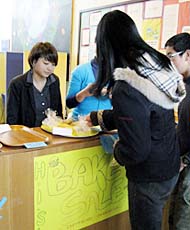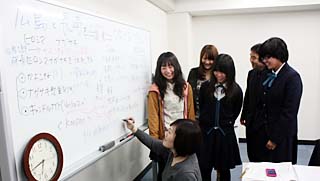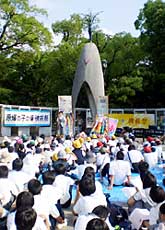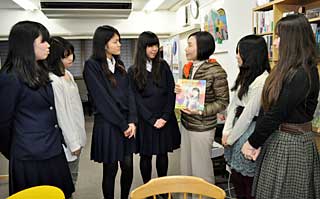Junior High and High School students pursue peace activities
Conveying Hiroshima's experience
For this issue of Peace Seeds, the junior writers report on peace activities being carried out by junior high and high school students of the same generation. In their aim to convey Hiroshima's experience of the atomic bombing, they are engaged in a range of activities, such as listening to the talks of A-bomb survivors and experts and making animated films. They are also active in fundraising efforts for the people affected by the earthquake and tsunami that recently ravaged eastern Japan.
Through our coverage of these peace activities, the junior writers have come to feel strongly about taking action for peace. We discussed our ideas and drew up some plans.
Our efforts may be small, but even so, we must put together small efforts like this and continue conveying the horror of nuclear weapons and appealing for the importance of peace. For those of us who live in the A-bombed city of Hiroshima, we believe this is our mission.
 Students at Hiroshima International School sell cakes and cookies to support the survivors of the earthquake and tsunami. (Seira Furukawa, 17)
|
Providing support for people in the disaster zone
Seeking to provide support to the victims of the earthquake and tsunami that struck eastern Japan on March 11, junior high and high school students in Hiroshima Prefecture have become involved in fundraising activities.
On the mornings of March 15 to 18, students of Hiroshima Jogakuin Junior High School engaged in a fundraising campaign in front of the entrance to their school. A third-year student, Sae Murai, 15, told us, "Our own daily lives are continuing, as usual, but terrible things are happening in another part of Japan. I can't go to the disaster area, but I'm eager to do something to help." She shared her hopes that the crisis at the Fukushima No. 1 nuclear power plant won't grow any more serious.
At Hiroshima International School, students from kindergarten on up brought homemade cakes and cookies to school and held a bake sale on March 25. The proceeds from the sale are being donated through the NGO "Plan Japan" to aid children in the affected areas.
At Hiroshima Prefectural Hiroshima Junior/Senior High School, students also are engaged in a fundraising effort, and such fundraising campaigns are spreading to many other schools. (Akane Murashige, 18)
|
Making an animated film The art club at Ushita Junior High School has made a short animated film based on a song about peace called "Our Wish." They created around a thousand pictures that depict images from the lyrics of the song, including the abolition of weapons and landmines and the advance of peace in the world, then they put the pictures together in scenes to produce a film that runs 8 minutes and 20 seconds. The song "Our Wish" was conceived in a peace education class at Ozu Junior High School in Hiroshima in 2002. The class originally made four verses, and since then, other verses for the song have been contributed from all over the world. Today, the song has more than 2,000 verses. Members of the Ushita Junior High School art club chose five of these verses, such as "If a flying fighter plane was a shooting star..." then drew a storyboard and completed the pictures for the film in about two months. Izumi Morino, 15, a third-year student, shared her hopes, saying, "I want to help make a world without conflict, where children can laugh." The art club plans to produce further films based on the song. Their film can be viewed at the Ushita Junior High School website. (Akane Murashige, 18)
|
Joining hands with Nagasaki
 Members discuss their future plans, such as listening to the accounts of A-bomb survivors from Nagasaki. (Photo taken by Marina Ishioto, 15)
|
A group run by mainly high school and university students was established in January 2011. The group seeks to promote peace and abolish nuclear weapons by serving as a bridge between the two A-bombed cities of Hiroshima and Nagasaki. They plan to learn about the horrific experiences of the bombings, the history of the reconstruction of the cities, and convey this information to others.
The office for the group is located in downtown Hiroshima and they will begin their full-scale activities in April. One objective of the group is to listen to the stories of A-bomb survivors from Hiroshima and Nagasaki and people engaged in peace activities. On the anniversary of the day when the atomic bomb was dropped on Nagasaki, August 9, they will hold a memorial ceremony in Hiroshima. The group will also pursue the idea of publishing a "Hiroshima-Nagasaki newspaper" to share what they have learned.
Kanao Fukuoka, 18, the leader of the group and a student at Hiroshima Nagisa High School, shared her aspirations, saying, "I intend to take advantage of the chance to meet many other people and strengthen Hiroshima's ties with Nagasaki in order to advance the momentum for the abolition of nuclear weapons. (Minako Iwata, 17, and Yuka Ichimura, 14)
|
Volunteers take action
A volunteer group called "Hiroshima United Children," planned and run solely by junior high and high school students, was established in November 2010. The goal of the group is to promote peace from Hiroshima. Aiko Watanabe, 17, the leader of the group and a second-year student at Hiroshima Nagisa High School, told us, "With the A-bomb survivors getting old, I'm afraid the memory of the atomic bombing is fading. I want to think about peace with others of the same generation and pursue small activities that we can carry out in our daily lives." The group cleans up around the school and speaks with people involved in peace activities to get further ideas. They received some advice from Tomoko Watanabe, 57, the head of the NPO ANT-Hiroshima, who told them, "Accurately convey what happened in Hiroshima under the mushroom cloud." In July, the group plans to hold a forum for junior high and high school students from Hiroshima Prefecture to engage in discussion on the atomic bombings and peace. (Rena Sasaki, 14) |
 Ceremony organized by Noborimachi Junior High School, held in front of the Children's Peace Monument on July 23, 2010. (Photo courtesy of Noborimachi Junior High School)
|
Ceremony held at Children's Peace Monument
Noborimachi Junior High School was the school Sadako Sasaki attended. Sadako was a girl who experienced the atomic bombing at the age of two, and died of radiation-induced leukemia at the age of 12. Every July the current students of Noborimachi Junior High School hold a ceremony in front of the Children's Peace Monument in Hiroshima Peace Memorial Park.
After Sadako's death, a movement to establish a monument in her honor, and in honor of all children affected by war, spread across Japan. Students of Noborimachi Junior High School at that time launched a fundraising campaign and advanced the movement to raise the monument.
Last year about 400 students from elementary schools and junior high schools in Hiroshima took part in the ceremony. Mei Nagasako, 15, the former president of the Noborimachi Junior High School student council, read aloud a "Peace Appeal" that the students wrote and pledged that they would take action for a peaceful world free of weapons. "It's important to speak out," says Mei, "not simply have the thought that war is bad. As a child of Hiroshima, I want to convey my wish for peace to many people in the world." (Akane Murashige, 18)
|
Sadako in Europe
In the city of Maribor in northeastern Slovenia, a nation in Europe, there is a group called "One Thousand Cranes." We sent an e-mail message to a member of the group, Helena Schulz, 15, through a representative of the "Hiroshima Esperanto-Societo," Moritaka Oshioka. "One Thousand Cranes" was formed last year in cooperation with an A-bomb exhibition held at the National Liberation Museum. The group consists of four girls who are all 15. At the opening ceremony of the exhibition, the group introduced Sadako Sasaki, who died ten years after her exposure to the atomic bomb, and performed a dance depicting Sadako's life. Helena wrote, expressing her sense of mission: "When we think about the victims and the survivors who have struggled through their lives after experiencing the bombings, dropping the atomic bombs is unforgivable." The school which the girls attend is planning to hold an A-bomb exhibition of its own in June. "I intend to convey the horror of war to more students," Helena vowed. (Masaya Obayashi, 14) |
Karate club in France promotes peace
 Members of the karate club are engaged in efforts for nuclear abolition. (Photo courtesy of Claire Gandit)
|
A karate club in the city of Vaulx-en-Velin in southeastern France includes a group of youth, ages 16 to 18, engaged in a "Hiroshima-Nagasaki Project" with the aim of abolishing nuclear weapons. They launched the effort in 2009 when the participants grew interested in nuclear issues after seeing coverage about the nuclear development program in Iran.
The members of the group visited the United Nations branch in Geneva, Switzerland last year to learn about nuclear weapons and they held an A-bomb exhibition in France. The exhibition featured the French version of an animated film titled "Riding on a Crane," which was produced by Miho Cibot, a peace activist in France. The film is based on the story of Sadako Sasaki.
The group plans to visit Hiroshima and Nagasaki this summer. One member, Claire Gandit, 17, told us, "After we return to France, I want to share the accounts and the photos of A-bomb survivors to young people in our area. I want to convey how important it is to abolish nuclear weapons."
|
"Our Wish" sung in Italian At Cavour Junior High School in the city of Modena in northern Italy, there is a group called "Little Foxes." It was formed in 2005 and its members have been engaged in learning about different cultures. The group is working to translate the lyrics of "Our Wish," a song about peace that was born in Hiroshima, into Italian. The song was conceived in a peace education class at a junior high school in Hiroshima and, since then, new verses have been contributed by people all over the world. To date, there are more than 2,000 verses. Martina Benincasa, 14, a representative of the group, remarked, "I feel a message of hope and peace from the song, and the melody is beautiful." In May an A-bomb exhibition will be organized in Modena. Martina told us that she is studying about the Holocaust and about the atomic bombing of Hiroshima at her junior high school. "I want to interact with other junior high or high school students," she said, "and exchange information on people's accounts of World War II." |
Advice from a former member of "United Children," Masatoshi Wakazawa

"Please continue your activities without forgetting the vision you had when you started the group." These are the words of Masatoshi Wakazawa, 21, a second-year student at Tokyo University. Masatoshi is the head of a group of former members of "United Children" (UC), an alliance of junior high and high school students working as volunteers in 45 places in Japan.
Masatoshi offers advice to younger students taking part in UC. With regard to finding new members, a crucial part of undertaking activities, he says, "First, talk about what you can do with your friends." On the subject of problems, he adds, "Speak to adults who have rich experiences and take advantage of the energy of junior high and high school students."
Having a clear plan is important, too. At times, the members of your group may not be able to find agreement on certain matters. "When you run into this," Masatoshi says, "it's important to reflect on your initial motivation for starting the group." He cautions, "If your motivation is too light, and you're just interested in some short-term volunteer activity, then it will turn out to be only a group of friends."
In order for the group's activities to be sustained for a long time, it's vital to give some substantial roles to the younger members of the group and share your ideas with them. After you leave the group, Masatoshi recommends meeting with the current members from time to time. He stresses, "Maintain your relationship with the group in the event that your help is needed." (Rena Sasaki, 14)
Four things we wish to do
At the conclusion of our coverage for this issue, the junior writers held a discussion about the kinds of peace activities we would like to pursue. We have compiled our ideas into four plans.
 |
Organize a global voyage for junior high and high school students |
Raise donations and make preparations for a voyage by ship. There are no national borders on board a ship. Teens from across the world gather in Hiroshima and then head out on a global voyage, stopping at a number of ports. Such stops might include: African nations suffering from poverty; New York City, where the headquarters of the United Nations is located; Costa Rica, which has a "peace constitution"; and the Moruroa Atoll, where nuclear testing was conducted. On board the ship, the participants engage in discussion on war and ethnic conflict in order to deepen their understanding of these issues.
 |
Learn about Hiroshima's experience of the atomic bombing |
Visit Peace Memorial Museum in Hiroshima and listen to the stories of A-bomb survivors. Learn why Japan was waging war, what sort of damage was wrought by the war, and how the city of Hiroshima was reconstructed.
 |
Exchange pictures on the theme of peace |
Children around the world draw pictures on the theme of peace and exchange their art work. The pictures are also posted on the Peace Seeds website. At Peace Memorial Park in Hiroshima, a sketching event could be held and the pictures produced by a lot of children there would be collected, too.
 |
Deepen understanding with junior high and high school students from different countries |
Create opportunities to talk with junior high and high school students visiting from overseas and spread the wish for peace at the grassroots level. We could invite children affected by war to come to Hiroshima and we would share with them the history of Hiroshima's reconstruction to give them hope. We could also make a junior high and high school students' version of the "Peace Declaration" and present it on August 6.


